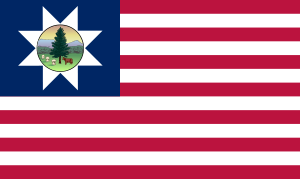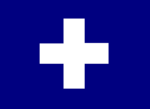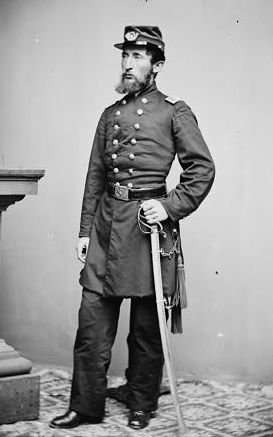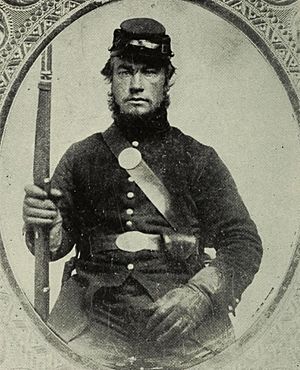3rd Vermont Infantry Regiment facts for kids
Quick facts for kids 3rd Vermont Infantry Regiment |
|
|---|---|

Flag of Vermont, 1837–1923
|
|
| Active | July 16, 1861 to July 11, 1865 |
| Allegiance | Union |
| Branch | United States Army Union Army |
| Type | Infantry |
| Size | 1,748 |
| Engagements | Battle of Williamsburg Battle of Savage's Station Battle of Antietam Battle of Fredericksburg Battle of Chancellorsville Second Battle of Fredericksburg Battle of Salem Church Battle of Gettysburg Battle of the Wilderness Battle of Spotsylvania Court House Battle of Cold Harbor Siege of Petersburg |
| Disbanded | July 11, 1865 |
| Commanders | |
| Colonel | John W. Phelps |
| Colonel | William Farrar Smith |
| Lieutenant Colonel | Wheelock G. Veazey |
| Insignia | |
| 2nd Brigade (Vermont Brigade), 2nd Division, VI Corps (Union Army), Army of the Potomac/Army of the Shenandoah (Union) |  |
The 3rd Vermont Infantry Regiment was a group of soldiers who fought for the Union Army during the American Civil War. They were an infantry regiment, meaning they were foot soldiers. They served for three years, from July 1861 to July 1865. Most of their time was spent in the eastern part of the war, as part of the VI Corps in the Army of the Potomac. This regiment was also a key part of the famous Vermont Brigade.
Contents
History of the Regiment
In July 1861, the United States Congress allowed President Abraham Lincoln to ask for 500,000 men to join the army. These soldiers would serve for three years. The 3rd Vermont Infantry was the second group from Vermont to join the war effort. It was made up of local militia companies from towns like Springfield, Coventry, and St. Johnsbury.
The soldiers gathered in St. Johnsbury at a place called "Camp Baxter." They officially joined the United States Army on July 16, 1861. Soon after, on July 24, they left for Washington, D.C.. Their commander, Colonel William Farrar Smith, met them in Hartford, Connecticut.
The regiment arrived in Washington, D.C., on July 25, 1861. Two days later, they marched to the Chain Bridge over the Potomac River. There, they built a camp they called "Camp Lyon." Other army units, like the 6th Maine Infantry, joined them at this location.
Changes in leadership happened early on. Major Walter W. Cochran left due to illness. Captain Wheelock G. Veazey took his place. When Colonel Smith became a brigadier general, Lieutenant Colonel Breed N. Hyde became the new colonel. Captain Thomas O. Seaver was promoted to major.
A famous event happened at Camp Lyon involving Private William Scott. He was found asleep while on guard duty on August 31. This was a serious offense, and he was sentenced to be executed. However, President Lincoln heard about Scott's case and decided to pardon him. Scott was actually standing in front of a firing squad when his pardon was read. He later continued to serve bravely with his regiment. Sadly, William Scott was killed in action at the Battle at Lee's Mill (a/k/a Dam No. 1).
On September 3, the regiment moved across the Chain Bridge to "Camp Advance." On September 11, they went on a scouting mission near Lewinsville, Virginia. They met Confederate soldiers and came under fire. Private Amos Meserve was killed, and others were wounded. Later, on September 25, they went on another scouting mission without any injuries.
Over the next few weeks, more Vermont regiments joined Smith's division. On October 9, all the Vermont regiments moved to Camp Griffin. On October 24, the 6th Vermont Infantry arrived. This completed the formation of what became known as the "Old Vermont Brigade." From this point on, the 3rd Vermont Infantry's story is largely the story of the Vermont Brigade.
Many of the original soldiers who did not choose to re-enlist left the army on July 27, 1864. The remaining soldiers and new recruits were combined into fewer companies. The last of the soldiers from the 3rd Vermont Infantry Regiment officially left the army on July 11, 1865.
Brave Actions: Medal of Honor
The Medal of Honor is the highest award a soldier can receive for bravery. Six members of the 3rd Vermont Infantry Regiment earned this special medal for their heroic actions.
- Alexander M. Beattie, a Captain, bravely moved a wounded soldier to safety while under heavy enemy fire at the Battle of Cold Harbor on June 5, 1864.
- Gardner C. Hawkins, a 1st Lieutenant, bravely led his fellow soldiers forward when they were struggling under enemy fire. Even though he was badly wounded, he stayed on the battlefield until their goal was achieved at the Battle of Petersburg on April 2, 1865.
- Willie Johnston, a Musician, was one of the very first people to ever receive the Medal of Honor.
- Samuel E. Pingree, a Captain, bravely led his company across a wide creek. They drove the enemy out of their hiding spots and he stayed with his men even after being wounded a second time at the Battle at Lee's Mills on April 16, 1862.
- Julian A. Scott, a Drummer, repeatedly crossed a creek under intense enemy fire to help bring wounded soldiers to safety at the Battle at Lee's Mills on April 16, 1862.
- Thomas O. Seaver, the Colonel, bravely led three regiments to attack and capture enemy positions while under heavy fire at the Battle of Spotsylvania on May 10, 1864.
Major Battles and Fights
The 3rd Vermont Infantry Regiment took part in many important battles and smaller fights during the Civil War. Here are some of them:
| ENGAGEMENTS | |
|---|---|
| Battle of Lewinsville | September 11, 1861 |
| Battle at Lee's Mill | April 16, 1862 |
| Battle of Williamsburg | May 5, 1862 |
| Battle of Garnett's & Golding's Farm | June 26, 1862 |
| Battle of Savage's Station | June 29, 1862 |
| Battle of White Oak Swamp | June 30, 1862 |
| Battle of Crampton's Gap | September 14, 1862 |
| Battle of Antietam | September 17, 1862 |
| Battle of Fredericksburg | December 13, 1862 |
| Battle of Marye's Heights | May 3, 1863 |
| Battle of Salem Church | May 4, 1863 |
| Second Battle of Fredericksburg | June 5, 1863 |
| Battle of Gettysburg | July 3, 1863 |
| Battle of Funkstown | July 10, 1863 |
| Battle of Rappahannock Station | November 7, 1863 |
| Battle of the Wilderness | May 5–10, 1864 |
| Battle of Spotsylvania | May 10-18, 1864 |
| Battle of Cold Harbor | June 1-12, 1864 |
| Battle of Petersburg | June 18, 1864 |
| Battle of Reams' Station | June 29, 1864 |
| Fort Stevens (Washington, D.C.) | July 11, 1864 |
| Battle of Charlestown | August 21, 1864 |
| Battle of Opequon (Gilbert's Ford) | September 13, 1864 |
| Battle of Winchester (Opequon) | September 19, 1864 |
| Battle of Fisher's Hill | September 21-22, 1864 |
| Battle of Cedar Creek | October 19, 1864 |
| Battle of Petersburg | March 25, 1865 |
| Battle of Petersburg | April 2, 1865 |
Regiment's Numbers
This table shows the total number of soldiers who served in the 3rd Vermont Infantry and how many were lost during the war.
| FINAL STATEMENT | |
|---|---|
| Original members | 881 |
| Gain (recruits and transfers) | 928 |
| --- Total Soldiers | 1809 |
| --- Losses --- | |
| Killed in action | 131 |
| Died of wounds | 65 |
| Died of disease | 152 |
| Died in Confederate prisons | 11 |
| Died from accident | 3 |
| Total Deaths | 362 |
| Promoted to other regiments | 11 |
| Honorably discharged | 474 |
| Dishonorably discharged | 12 |
| Deserted | 261 |
| Finally unaccounted for | 9 |
| Transferred to Veteran Reserve Corps and other organizations | 101 |
| --- Total Losses | 868 |
| Mustered out at various times | 579 |
| Total wounded | 428 |
| Total taken prisoner | 78 |



